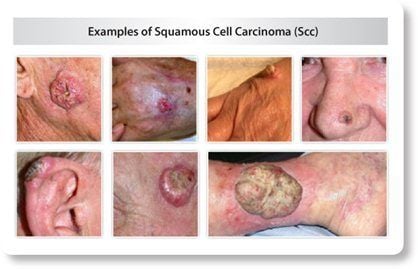What is an SCC (Squamous Cell Carcinoma)?
)
Squamous cell carcinoma (SCC), is the second most common form of skin cancer. This cancer is an uncontrolled growth of abnormal cells arising from the squamous cells in the epidermis, the skin's outermost layer. It is sometimes called cutaneous squamous cell carcinoma (CSCC) to differentiate it from very different kinds of SCCs elsewhere in the body (e.g. lung). Cutaneous is the scientific word for "related to or affecting the skin."
More than 1 million cases of squamous cell carcinoma are diagnosed each year. Incidence has increased significantly in the past three decades.
What do SCC's look like?
SCC's can appear in different forms:
- Scaly red patches
- Open sores that don't heal
- Warts that grow in size
- Recurrent scabbing or crusting
- Wet, fungating growth that oozes and/or bleeds
- Nodules that grow rapidly or elevated growths with a central depression
SCCs may occur on all areas of the body, including the mucous membranes and genitals, but are most common in areas frequently exposed to the sun, such as the rim of the ear, lower lip, face, balding scalp, neck, hands, arms and legs. The skin in these areas often reveals telltale signs of sun damage, including wrinkles, pigment changes, freckles, "age spots," loss of elasticity and broken blood vessels.
Are SCC's dangerous?
If caught early, most squamous cell carcinomas are curable and cause minimal damage. However, the larger and deeper a tumour grows, the more dangerous and potentially disfiguring it may become, and the more extensive the treatment must be. SCC's can be classified according to their pathological grades. The most common form is SCC-in-situ which is also known as Bowen's Disease, or Intraepidermal Carcinoma (IEC). These are SCC's on the very surface of the skin, which has not yet developed the potential to invade or spread. Invasive SCC's are divided into three grades: well-differentiated, moderately differentiated and poorly differentiated in the order of least aggressive to the most aggressive. Poorly differentiated SCC's are known to grow rapidly, metastasis and can be highly recurrently. If left untreated, SCCs may spread (metastasize) to local lymph nodes, distant tissues and organs and can become life-threatening. Treatment of metastatic SCC often include extensive surgery, radiotherapy and chemotherapy.
What are SCC's caused by?
Cumulative, long-term exposure to ultraviolet (UV) radiation from the sun over your lifetime causes most SCCs. Daily year-round sun exposure, intense exposure in the summer months or on sunny vacations and the UV produced by indoor tanning devices all add to the damage that can lead to SCC. Experts believe that indoor tanning is contributing to an increase in cases among young women, who tend to use tanning beds more than others do.
How are SCC's diagnosed?
SCC's are diagnosed with a biopsy (a sample of tissue from the lesion), which is examined under a microscope by a pathologist. Often, the subtype/grade of the SCC can be determined with the biopsy sample.
What are the treatments available for SCC's?
Fortunately, there are several effective ways to eradicate squamous cell carcinoma. Treatment recommendation is based on the tumor's type, size, location and depth of penetration, as well as the patient's age and general health. IEC's can generally be treated with topical treatment or minor surgery. Invasive SCC's often require surgery, with or without adjuvant radiotherapy.
Talk to your doctor about your best options of treatment.
To find out more about Skin Cancer and Surgery, visit our page on Skin Cancer Surgery or read our blogs on skin cancers.
| Tags:Skin Cancersplastic surgerySkin |

